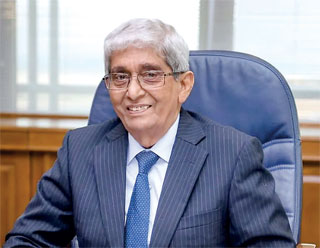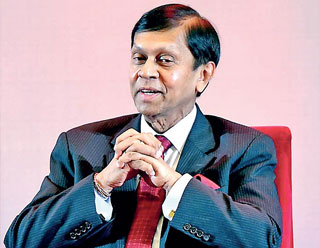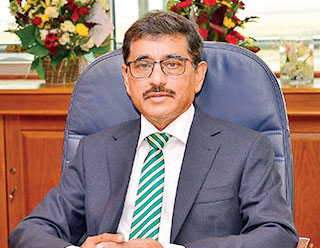Monday Apr 28, 2025
Monday Apr 28, 2025
Monday, 28 November 2022 01:09 - - {{hitsCtrl.values.hits}}

W.D. Lakshman

Ajith Nivard Cabraal

Nandalal Weerasinghe
|
 An unwarranted public debate
An unwarranted public debate
There is an unwarranted public debate taking place in Sri Lanka today. That is, of the three Central Bank governors in the last three years, W.D. Lakshman, Ajith Nivard Cabraal, and Nandalal Weerasinghe, who has printed the biggest quantity of money leading to the present galloping inflation recorded at about 70% per annum.
Many consider money printing as an evil activity and previously, both Lakshman and Cabraal were blamed for liberally engaging in this evil activity. But now, the new Governor Nandalal is also being charged by some critics, including some legislators, that he has printed more money when measured on a per diem basis, than his two predecessors. They present the weekly increase in the Central Bank’s holding of government Treasury bills as evidence.
Poor literacy of monetary theory
This argument is erroneous and demonstrative of the critics’ poor literacy of monetary theory. First, money is not what the Central Bank lends the Government. It is the total money liquidity in the hands of the people enabling them to buy baskets of real goods and services. That stock of money, known as money supply, has been defined by the central bank as currency issued by the central bank and held by the public, demand deposits held by the public in commercial banks, time and savings deposits of the public held in commercial banks, and a half of the non-resident foreign currency deposits of the public with commercial banks. For ease of presentation, this money stock is coded as M2b.
Money is a mental thought and not a real asset
Two further clarifications here: public means anyone not belonging to the government, a commercial bank, or the central bank. They are the general people of the country who buy real goods and services and sell real goods and services. A real product means any good or service which people can use for their consumption or as an input for further production. An obvious example is ‘de-husked paddy’ which can be eaten as cooked rice or used for producing rice noodles. Money is simply a facilitator for people to acquire these real goods and services. Hence, money itself does not give us any pleasure, called utility in economics. Its utility is its ability to help us acquire these real goods and services which we can consume for pleasure. As such, money is simply a notion in our meds and can be called a mental thought.
Track record of the three governors
Any increase in this stock is ‘money printing’ and any decline is ‘money burning’. This stock stood at Rs. 7,624 billion as at the end of 2019 when Lakshman became the Governor. By end-September 2021 when he resigned from the governorship, it had ballooned to Rs. 10,488 billion indicating an increase of Rs. 2,864 billion or 38%. When Cabraal resigned as Governor in early April 2022, M2b stood at Rs. 11,575 billion, recording an increase of Rs. 1,087 billion or 10% during his tenure. Nandalal became the Governor in April 2022 and, according to the data released by the Central Bank, M2b at end-September 2022 amounted to Rs. 12,051 billion. During that period, M2b has increased by Rs. 476 or 4%. In terms of these numbers, Nandalal has the lowest record of money printing, but that conclusion is misleading as explained below.
All money increases are not evil
Money is needed for conducting economic activities and, therefore, not all money supply increases are evil, as believed by many. If money is not there in adequate amounts, we cannot conduct the transaction of real goods and services smoothly. Imagine a situation where you get into a bus, and you do not have enough liquid cash to pay your bus fare. You may have a Rolls Royce at home, but that Rolls Royce will not help you to pay your bus fare at that point of time. The chances are that, to your embarrassment, you may be thrown out of the bus unceremoniously. Hence, it is the job of the Central Bank to allow money supply to go up or go down as needed by the expansion of the economy. The bigger the production in the economy, bigger the quantity of money needed by it to exchange all those goods and services.
Accordingly, there is a safe method of supplying money to an economy by a central bank. That is, if it keeps the money supply growth equal to the growth in the real economy, it can keep the price level changes – known as inflation when it happens over a period – at a zero level. Therefore, permitting money supply to grow at the same rate as the real growth in the economy is not an evil activity. For instance, if the real economy grows at 10%, the central bank can allow the money supply to grow at 10% without compromising the price levels. But it will become evil if it allows money supply to grow higher than the real economic growth continuously and consistently causing people to suffer through inflation. When inflation is set in, its undesirable consequence is the depreciation of the exchange rate. The Central Bank should avoid both by keeping money supply growths within the limits.
Use of modern monetary theory by Lakshman and Cabraal for guidance
Both Lakshman and Cabraal are guilty of this evil activity because they publicly pronounced that there is no relation between money supply and inflation or exchange rate depreciation. They were guided by the ideology of a breakaway group of economists from the mainstream calling themselves modern monetary theorists. In fact, as I have argued earlier in this series, there was nothing about them being modern because their ideology had been presented to the world by the Scottish economist John Law in early 18th century. In a book he published in 1705 under the title Money and Trade Considered: with a Proposal for Supplying the Nation with Money, Law argued that money issue is an important monopoly being enjoyed by the king, and therefore, the king should supply money to facilitate international trade which was the source of prosperity at that time if a country was able to generate a trade surplus with other nations.
According to him, as long as money served this purpose, there was nothing wrong in increasing money supply liberally. Modern monetary theorists, without giving credit to John Law, have represented the same idea as guidance of policy by governments. For them, talking about an evil budget deficit is a myth. Governments should increase money freely and generate real economic growth.
The mistake which modern monetary theorists, Lakshman and Cabraal made, was that they thought money as a real good and not simply a facilitator. Hence, when you supply more money through the Government which runs a budget deficit, the welfare of the people will be greater. But when you consider money as a mental thought, more money means that you are in a bigger dream world believing everything that you dream. However, when you wake from the dream, you must face the harsh realities in the real world. That is what is happening to Sri Lankans today. They are suffering from both the exchange rate depreciation and high inflation. To his credit, Nandalal is not guilty of these evil utterances or activities.
It is Monetary Board that is responsible
Then, there is the governance structure of the Central Bank which is not immediately visible to outsiders. In terms of the law, there is no such institution called the central bank. Instead, it is the Monetary Board which has been incorporated under the law. It is that Monetary Board which is responsible for conducting monetary policy – the work involved in decisions relating to the money supply growth. The Governor is the Chairman of the Board, but he is not the board. There are four other board members, Secretary to the Ministry of Finance and three other outsiders competent in economics, finance, or banking. These four board members are expected to function independently according to their conscience, considering their duty by the people that they should protect the moneys held by them.
If there is an unreasonable demand made by the Governor or the Government, they have the full right to reject it and they should exercise that right for the benefit of the people. But if they have become a yielding hand to the Governor or the governmental authorities, they have failed in their responsibility. It is the very same Monetary Board which has existed during the three regimes of the governors at issue. Hence, like the governor, they are equally guilty of the evil activity of excessive money printing leading to exchange rate depreciation and inflation that Sri Lanka is experiencing today.
CB’s technical staff is not decision maker
Very often people question the role of the Central Bank’s technical staff, including deputy governors, in these evil activities. This question is also raised due to the ignorance of the above-mentioned governance structure of the Central Bank. The staff can make recommendations, but the Board can accept it, reject it, or modify it. The staff has no say about this. They may have made the correct recommendations, but if the Governor and the Board have rejected them, they are not responsible for the consequences of such policy actions. Unfortunately, within the present disclosure policy of the Central Bank, the staff cannot make its views known to the public.
There had been three previous occasions when the deputy governors had spoken out. The first was in 1983 when Deputy Governor H.N.S. Karunatilake spoke out. The second was in 1989 when Deputy Governor A.S. Jayawardena spoke out. The third was when Deputy Governor Nandalal Weerasinghe spoke out in 2020. On all these three occasions, they were prematurely retired from the Bank. However, a remarkable feature was that all three of them made a comeback and became the governor of the bank later.
It is reserve money and not lending to government that leads to money creation
Now let’s examine the Central Bank’s holding of Treasury bills as equivalent to its money printing. This is another half-truth relating to the subject. Central banks throughout the world, by the mere ability to issue currency, are able to acquire assets simply by making a book entry. Those assets can be lending to the government, lending to commercial banks, lending to the staff as welfare loans, or the acquisition of fixed assets like buildings, computer systems, etc. When it does so, it adds to its assets and creates a liability in the form of new currency issued or crediting the accounts of the government or the commercial banks, or simply reduction in the capital if the transaction involved amounts to losses.
All these asset acquisitions are new money creations. Therefore, they are called new reserve money creation by the central bank. Such reserve money, once released to the economy either through the government or through commercial banks, is used by commercial banks to create further deposits and credit. Such deposits held by the public as well as the currency originally issued by the central bank together make the money supply of the country. The present conditions in the financial system in Sri Lanka allow commercial banks to create this final money 8 times more than the reserve money created by the Central Bank within about 18-24 months. Accordingly, if the Central Bank lends Rs. 1 to the Government, it will ultimately create another Rs. 8 within the country’s banking system.
Hence, the money supply increases that we observe today are the result of the reserve money created by the Central Bank some two years ago. This is known as the multiple money creation process and the overall reserve money level functions as the seed money creation by the Central Bank. Hence, if any governor is guilty of the so-called evil activities, it is according to the reserve money his administration has created and not just the lending to the Government or commercial banks.
|
Track record of reserve money increases
During 2010 to 2014, the reserve money level on average amounted to Rs. 470 billion per annum. Reflecting on the increased bank financing for budgetary funding, during 2015 to 2019, reserve money on average shot up to Rs. 872 billion per annum and this growth has been an unwarranted one. This is because commercial banks will create Rs. 8 by using every rupee created by the Central Bank as reserve money leading to a total money stock of some Rs. 7 trillion, up by some Rs. 3 trillion from the level of the previous administration. Hence, money supply increases that we observe today are the handiwork of those who ran the Central Bank in the past.
To add fuel to fire, Lakshman allowed the reserve money base to shoot up to Rs. 1,306 billion by the end of 2021. During the first 11-month period of 2022, reserve money base has increased marginally to Rs. 1,379 billion. Consequently, today’s reserve money base will cause money supply to increase in another 18 to 24 months but marginally from the current levels since it has been only a marginal increase.
However, things will be different if the Monetary Board led by Nandalal Weerasinghe accommodates President Ranil Wickremesinghe’s demand for Rs. 1 trillion from the Central Bank to pay salaries to public servants in the next six-month period. This will be a real possibility since his budget 2023 is a very fragile one with a massive total Government expenditure of Rs. 7.9 trillion officially but Rs. 11.7 trillion when missing items are also added and poor prospect of raising revenue from taxes and the sale of Government assets. If this Rs. 1 trillion is accommodated, reserve money rising to Rs. 2.4 trillion will make a monetary explosion by 2025.
Money creation is a process
What this means is that money printing as perceived by the general public is a process of which the consequences of what is done today are known only with a time lag of some 18 to 24 months. That is why I said at the beginning we should not hasten to brand this governor is eviler and that governor is a saint. The initial reserve money expansion orchestrated by Lakshman and Cabraal has not run its full course as yet. Hence, it is misleading to catch them midway through and award them certificates of good behaviour. In that context, Nandalal’s track record so far is creditable. But that will be reversed if the Monetary Board led by him accommodates the President’s voracious demand for Central Bank funding in larger volumes given the unmitigated increase in the total expenditure of the Government to some Rs. 11.7 trillion in budget for 2023.
(The writer, a former Deputy Governor of the Central Bank of Sri Lanka, can be reached at [email protected].)
Discover Kapruka, the leading online shopping platform in Sri Lanka, where you can conveniently send Gifts and Flowers to your loved ones for any event including Valentine ’s Day. Explore a wide range of popular Shopping Categories on Kapruka, including Toys, Groceries, Electronics, Birthday Cakes, Fruits, Chocolates, Flower Bouquets, Clothing, Watches, Lingerie, Gift Sets and Jewellery. Also if you’re interested in selling with Kapruka, Partner Central by Kapruka is the best solution to start with. Moreover, through Kapruka Global Shop, you can also enjoy the convenience of purchasing products from renowned platforms like Amazon and eBay and have them delivered to Sri Lanka.
Discover Kapruka, the leading online shopping platform in Sri Lanka, where you can conveniently send Gifts and Flowers to your loved ones for any event including Valentine ’s Day. Explore a wide range of popular Shopping Categories on Kapruka, including Toys, Groceries, Electronics, Birthday Cakes, Fruits, Chocolates, Flower Bouquets, Clothing, Watches, Lingerie, Gift Sets and Jewellery. Also if you’re interested in selling with Kapruka, Partner Central by Kapruka is the best solution to start with. Moreover, through Kapruka Global Shop, you can also enjoy the convenience of purchasing products from renowned platforms like Amazon and eBay and have them delivered to Sri Lanka.